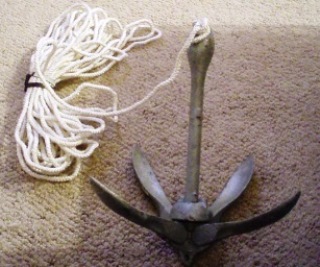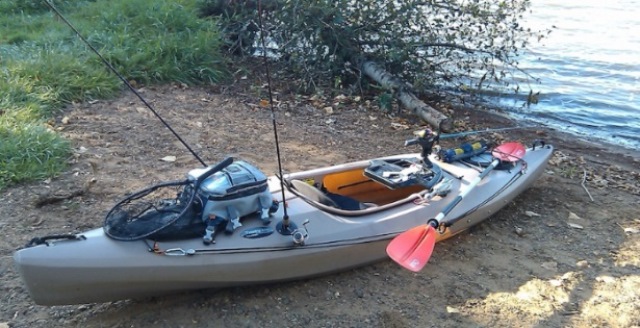I realize that not everyone that buys a kayak is looking to wet a line, but some of you may be curious or in some cases ready to jump right in. While fishing from a kayak is almost as simple as fishing off the bank, you do need to consider a few differences. In this article, I’ll cover the basics of outfitting your kayak for fishing, what to expect on your first fishing adventure, and a couple of tips to make your experience a safer more enjoyable one.
Outfitting Your Kayak
The fact of the matter is you really don’t need much to get your kayak outfitted for fishing. When somebody asks me what it takes to turn a kayak into a fishing kayak, I jokingly say “grab a rod next time you go paddling and go fish.” While that holds a lot of truth, the reality is there is a massive selection of products to help make your experience a better one. While many anglers customize their boats with hundreds of dollars’ worth of gear, you can start with a few basic items.
Rod Holder
Get your rod out of the way and secure it.
You need something to keep your rods in place. Your boat can flip or your rod can get hung up on a tree. Last thing you want to do is lose your rod and reel combo. Rod holders are typically made of plastic material and can be mounted with bolts or rivets. Two of the most typical applications include:
Flush Mounted Rod Holder
A tube that is inserted into your kayak or sometimes molded into the boat. The end of the rod is simply inserted into the tube and can then be secured with a rod leash. Flush Mount Rod Holders are usually installed behind the seat on the top deck area.
Secure Mounted Rod Holder
Provides a more secure hold than a Flush Rod Holder by “grasping” your rod and reel. You’ll typically find these installed on the center of the deck between your lower legs and sometimes behind the seat. The adjustability of these make them a popular choice when you want to keep your rod tips pointed lower than the flush mount option allows.
Kayak Crate/Tackle Boxes
Another popular option combines both tube like rod holders with a crate or boxed in area with a lid to store and protect your gear all in one easy to manage package.
Anchors
Stop your boat or you may miss the fish.

Like fishing from a motorboat, you’ll want to stay put when you find that “honey hole”. Securing your kayak in a specific location is key when fishing and there is no better way to do it than with a small anchor and line. Since you are limited on space and capacity, don’t get anything over 3 lbs. The two that we recommend are:
Folding Anchors
Folding anchors tend to be the most popular design due to their ability to provide a good hold in most environments and their portability.
Claw Anchor
If you want an anchor that can hold you in place even in the softest bottoms, this is the anchor you need. It may not be as portable as a folding anchor, but you can rest assured you won’t be going anywhere.
Paddle Leash
When a fish is on, the last thing on your mind will be your paddle.
Secure your paddle. We’ve all heard the term “up the creek without a paddle”–avoid it. By installing a simple device that secures your paddle to your boat, you’ll never have to worry about losing a paddle when you catch the “big one.” One end simply ties to a piece of hardware or installed accessory on the boat and the other to your paddle shaft. The leash is typically coiled or made of a “bungee” material. Most kayaks also have built in paddle tie downs but leashes are easier to deal with when in the moment.
That’s about all you’ll need to get started assuming you already purchased a paddle and PFD. However, you will find hundreds if not thousands of great products made specifically for kayak fishing, such as anchor trolleys, drift chutes, kayak rudders, stake out poles, and much more.
What to Expect When Kayak Fishing
Planning Ahead
Fishing can be addictive. What was supposed to be a one-hour fishing trip can easily turn in to half a day excursion especially when the fish aren’t biting. Expect to fish longer than you plan and be prepared. Load up a small ice chest with plenty of water, snacks, and a sack lunch. Be sure to bring plenty of sunscreen and/or apparel made for spending long periods of time outdoors.
 |
Launching Your Boat
As you prepare to launch your boat, keep in mind that with all the extra gear you Kayak Launching have, it may paddle a bit differently than you are used to. Balance your gear with the heaviest items towards the center of the boat. When launching, be aware that depending on how much gear you’ve loaded, your freeboard (boat out of the water) may be less than you than what you typically experience.
Understanding Fish From Above
The good news is that what makes kayaks a popular choice is their “stealthiness.” As you creep closer to your honey hole, you can easily glide into position with a few gentle paddle strokes. Just be careful not to bang your boat when putting your paddle down and lifting a rod, the slightest bump will scare them away.
Catching a Fish
So what do I do when I catch a fish on a kayak? May seem like a silly question but for those that have never fished off a kayak, this is a very important one. Make sure your hook is set and stay focused. Keep a tight line by holding your rod up above your head (watch out for those trees) while you double check to make sure your paddle is secure. If you are anchored down, try to steer your fish away from the anchor line or this could quickly get messy. Once you reel your fish close enough to land it (always leave some slack in your line), do take care in how you handle the fish especially if you plan to catch and release.
Safety!
Not to scare you out of kayak fishing, but you are introducing the possibility of getting yourself hooked, bitten by a snake or some creepy crawler, and dealing with less than ideal weather conditions. Of course this is the same with any paddling sport, but as an angler, you will find yourself under trees, into waters full of vegetation, and along banks making yourself more susceptible to encountering wildlife. Be cautions of your surroundings, always take a first aid kit, and like any other paddling sport, wear a PFD! I can’t stress how important this.
Tips

Go Easy on The Gear
I could write an entire book on the type of actual fishing gear you’ll need, but since it can vary so much by style, season, body of water, and region, we’ll stick to the kayaking aspect for the sake of this article. That said, I recommend you do some research, find what’s biting and where, and the gear other anglers are using.
Secure Your Gear
The best thing you can do to avoid losing your gear is to properly secure it. This includes your paddle, anchor, tackle boxes, etc. If you don’t have lash points, install some simple pad eyes and get some deck line. While bungee is great for securing a few large and light items, it may not hold up to some of your heavier gear such as a tackle box or ice chest. Tie it down!
Go With the One That Knows
Most kayak anglers are introduced to kayak fishing from those who Kayak Anglers already have some experience with it. That is hands down the best scenario. If you have yet to be invited, invite yourself or join a local forum or group. Those with experience are a wealth of knowledge. Learn from them. A word of advice, search the forums before you go posting “Hey, I’m a newbie that’s never been kayak fishing, any advice?” Chances are, hundreds of others have already asked the same questions you are about to ask and the answers may be there right there in front of you.

